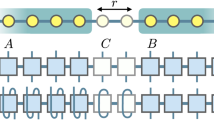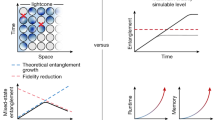Abstract
Entanglement is a distinguishing feature of quantum many-body systems, and uncovering the entanglement structure for large particle numbers in quantum simulation experiments is a fundamental challenge in quantum information science1. Here we perform experimental investigations of entanglement on the basis of the entanglement Hamiltonian (EH)2 as an effective description of the reduced density operator for large subsystems. We prepare ground and excited states of a one-dimensional XXZ Heisenberg chain on a 51-ion programmable quantum simulator3 and perform sample-efficient ‘learning’ of the EH for subsystems of up to 20 lattice sites4. Our experiments provide compelling evidence for a local structure of the EH. To our knowledge, this observation marks the first instance of confirming the fundamental predictions of quantum field theory by Bisognano and Wichmann5,6, adapted to lattice models that represent correlated quantum matter. The reduced state takes the form of a Gibbs ensemble, with a spatially varying temperature profile as a signature of entanglement2. Our results also show the transition from area- to volume-law scaling7 of von Neumann entanglement entropies from ground to excited states. As we venture towards achieving quantum advantage, we anticipate that our findings and methods have wide-ranging applicability to revealing and understanding entanglement in many-body problems with local interactions including higher spatial dimensions.
This is a preview of subscription content, access via your institution
Access options
Access Nature and 54 other Nature Portfolio journals
Get Nature+, our best-value online-access subscription
$29.99 / 30 days
cancel any time
Subscribe to this journal
Receive 51 print issues and online access
$199.00 per year
only $3.90 per issue
Buy this article
- Purchase on Springer Link
- Instant access to full article PDF
Prices may be subject to local taxes which are calculated during checkout



Similar content being viewed by others
Data availability
The experimental data presented in this manuscript can be found in the Zenodo repository, https://doi.org/10.5281/zenodo.8279583.
Code availability
Authors agree that, on request, the analysis code will be provided by the corresponding author.
References
Gross, D., Sevrin, A. & Zoller, P. (eds) The Physics of Quantum Information (World Scientific, 2023).
Dalmonte, M., Eisler, V., Falconi, M. & Vermersch, B. Entanglement Hamiltonians: from field theory to lattice models and experiments. Ann. Phys. 534, 2200064 (2022).
Joshi, M. K. et al. Observing emergent hydrodynamics in a long-range quantum magnet. Science 376, 720 (2022).
Kokail, C., van Bijnen, R., Elben, A., Vermersch, B. & Zoller, P. Entanglement Hamiltonian tomography in quantum simulation. Nat. Phys. 17, 936 (2021).
Bisognano, J. J. & Wichmann, E. H. On the duality condition for a Hermitian scalar field. J. Math. Phys. 16, 985 (1975).
Bisognano, J. J. & Wichmann, E. H. On the duality condition for quantum fields. J. Math. Phys. 17, 303 (1976).
Miao, Q. & Barthel, T. Eigenstate entanglement: crossover from the ground state to volume laws. Phys. Rev. Lett. 127, 040603 (2021).
Zhang, J. et al. Observation of a many-body dynamical phase transition with a 53-qubit quantum simulator. Nature 551, 601 (2017).
Bohnet, J. G. et al. Quantum spin dynamics and entanglement generation with hundreds of trapped ions. Science 352, 1297 (2016).
Chen, C. et al. Continuous symmetry breaking in a two-dimensional Rydberg array. Nature 616, 691 (2023).
Semeghini, G. et al. Probing topological spin liquids on a programmable quantum simulator. Science 374, 1242 (2021).
Sompet, P. et al. Realizing the symmetry-protected Haldane phase in Fermi–Hubbard ladders. Nature 606, 484 (2022).
Léonard, J. et al. Realization of a fractional quantum Hall state with ultracold atoms. Nature 619, 495 (2023).
Zhang, W.-Y. et al. Scalable multipartite entanglement created by spin exchange in an optical lattice. Phys. Rev. Lett. 131, 073401 (2023).
Cirac, J. I., Perez-Garcia, D., Schuch, N. & Verstraete, F. Matrix product states and projected entangled pair states: concepts, symmetries, theorems. Rev. Mod. Phys. 93, 045003 (2021).
Ganahl, M. et al. Density matrix renormalization group with tensor processing units. PRX Quantum 4, 010317 (2023).
Acharya, A., Kypraios, T. & Guţă, M. A comparative study of estimation methods in quantum tomography. J. Phys. A Math. Theor. 52, 234001 (2019).
Amico, L., Fazio, R., Osterloh, A. & Vedral, V. Entanglement in many-body systems. Rev. Mod. Phys. 80, 517 (2008).
Dalmonte, M., Vermersch, B. & Zoller, P. Quantum simulation and spectroscopy of entanglement Hamiltonians. Nat. Phys. 14, 827 (2018).
Giudici, G., Mendes-Santos, T., Calabrese, P. & Dalmonte, M. Entanglement Hamiltonians of lattice models via the Bisognano-Wichmann theorem. Phys. Rev. B 98, 134403 (2018).
Zhu, W., Huang, Z., He, Y.-C. & Wen, X. Entanglement Hamiltonian of many-body dynamics in strongly correlated systems. Phys. Rev. Lett. 124, 100605 (2020).
Casini, H., Huerta, M. & Myers, R. C. Towards a derivation of holographic entanglement entropy. J. High Energy Phys. 2011, 1 (2011).
Cardy, J. & Tonni, E. Entanglement Hamiltonians in two-dimensional conformal field theory. J. Stat. Mech. 2016, 123103 (2016).
Anshu, A., Arunachalam, S., Kuwahara, T. & Soleimanifar, M. Sample-efficient learning of interacting quantum systems. Nat. Phys. 17, 931 (2021).
Garrison, J. R. & Grover, T. Does a single eigenstate encode the full Hamiltonian? Phys. Rev. X 8, 021026 (2018).
Calabrese, P. & Cardy, J. Entanglement entropy and quantum field theory. J. Stat. Mech. 2004, P06002 (2004).
Kokail, C. et al. Self-verifying variational quantum simulation of lattice models. Nature 569, 355 (2019).
Alba, V. Eigenstate thermalization hypothesis and integrability in quantum spin chains. Phys. Rev. B 91, 155123 (2015).
Alba, V., Fagotti, M. & Calabrese, P. Entanglement entropy of excited states. J. Stat. Mech. 2009, P10020 (2009).
Eisler, V., Giulio, G. D., Tonni, E. & Peschel, I. Entanglement Hamiltonians for non-critical quantum chains. J. Stat. Mech. 2020, 103102 (2020).
Elben, A. et al. Cross-platform verification of intermediate scale quantum devices. Phys. Rev. Lett. 124, 010504 (2020).
Elben, A. et al. The randomized measurement toolbox. Nat. Rev. Phys. 5, 9 (2023).
Casini, H. & Huerta, M. Reduced density matrix and internal dynamics for multicomponent regions. Class. Quantum Gravity 26, 185005 (2009).
Eisler, V., Tonni, E. & Peschel, I. Local and non-local properties of the entanglement Hamiltonian for two disjoint intervals. J. Stat. Mech. 2022, 083101 (2022).
Sels, D. & Wouters, M. Quantum statistical gravity: time dilation due to local information in many-body quantum systems. J. Phys. Conf. Ser. 880, 012047 (2017).
Zache, T. V., Kokail, C., Sundar, B. & Zoller, P. Entanglement spectroscopy and probing the Li–Haldane conjecture in topological quantum matter. Quantum 6, 702 (2022).
Li, H. & Haldane, F. D. M. Entanglement spectrum as a generalization of entanglement entropy: identification of topological order in non-Abelian fractional quantum hall effect states. Phys. Rev. Lett. 101, 010504 (2008).
Chandran, A., Khemani, V. & Sondhi, S. L. How universal is the entanglement spectrum? Phys. Rev. Lett. 113, 060501 (2014).
Murciano, S., Vitale, V., Dalmonte, M. & Calabrese, P. Negativity Hamiltonian: an operator characterization of mixed-state entanglement. Phys. Rev. Lett. 128, 140502 (2022).
Kim, I. H., Shi, B., Kato, K. & Albert, V. V. Modular commutator in gapped quantum many-body systems. Phys. Rev. B 106, 075147 (2022).
Ryu, S. & Takayanagi, T. Holographic derivation of entanglement entropy from the anti–de Sitter space/conformal field theory correspondence. Phys. Rev. Lett. 96, 181602 (2006).
Periwal, A. et al. Programmable interactions and emergent geometry in an array of atom clouds. Nature 600, 630 (2021).
Kranzl, F. et al. Controlling long ion strings for quantum simulation and precision measurements. Phys. Rev. A 105, 052426 (2022).
Jurcevic, P. et al. Quasiparticle engineering and entanglement propagation in a quantum many-body system. Nature 511, 202 (2014).
Porras, D. & Cirac, J. I. Effective quantum spin systems with trapped ions. Phys. Rev. Lett. 92, 207901 (2004).
Liang, Y.-C. et al. Quantum fidelity measures for mixed states. Rep. Prog. Phys. 82, 076001 (2019).
Flammia, S. T. & Liu, Y.-K. Direct fidelity estimation from few Pauli measurements. Phys. Rev. Lett. 106, 230501 (2011).
da Silva, M. P., Landon-Cardinal, O. & Poulin, D. Practical characterization of quantum devices without tomography. Phys. Rev. Lett. 107, 210404 (2011).
Cerezo, M. et al. Variational quantum algorithms. Nat. Rev. Phys. 3, 625 (2021).
Kandala, A. et al. Hardware-efficient variational quantum eigensolver for small molecules and quantum magnets. Nature 549, 242 (2017).
Rasmussen, C. E. & Williams, C. K. I. Gaussian Processes for Machine Learning (MIT Press, 2005); https://doi.org/10.7551/mitpress/3206.001.0001.
Sopena, A., Gordon, M. H., García-Martín, D., Sierra, G. & López, E. Algebraic Bethe circuits. Quantum 6, 796 (2022).
Fishman, M., White, S. R. & Stoudenmire, E. M. The ITensor software library for tensor network calculations. SciPost Phys. Codebases https://doi.org/10.21468/SciPostPhysCodeb.4 (2022).
Acknowledgements
C.K. and P.Z. thank D. Sels for discussions. This project has received funding from the European Union’s Horizon 2020 research and innovation programme under grant agreement no. 101113690 (PASQuanS2.1). C.K., R.v.B., T.V.Z. and P.Z. were supported by the US Air Force Office of Scientific Research through IOE grant no. FA9550-19-1-7044 LASCEM, the Austrian Research Promotion Agency contract 884471 (R.v.B.) and the Simons Collaboration on Ultra-Quantum Matter, which is a grant from the Simons Foundation (651440, P.Z.). M.K.J., F.K., C.F.R. and R.B. acknowledge financial support for the experiment from the Austrian Science Fund through the SFB BeyondC (F7110) and the Institut für Quanteninformation GmbH. This research was supported in part by the National Science Foundation under grant no. NSF PHY-1748958. The computational results presented have been achieved (in part) using the high-performance computer infrastructure LEO of the University of Innsbruck. Simulations were performed using iTensor53.
Author information
Authors and Affiliations
Contributions
M.K.J. and F.K. developed and conducted the experiment under the guidance of R.B. and C.F.R. C.K., R.v.B., T.V.Z. and P.Z. proposed the research and developed the quantum protocols. C.K., R.v.B. and M.K.J. performed the data analysis. C.K., R.v.B., T.V.Z. and P.Z. wrote the manuscript, and M.K.J. contributed texts on experimental setups. All authors contributed to the discussion of the results.
Corresponding author
Ethics declarations
Competing interests
The authors declare no competing interests.
Peer review
Peer review information
Nature thanks Anurag Anshu and the other, anonymous, reviewer(s) for their contribution to the peer review of this work. Peer reviewer reports are available.
Additional information
Publisher’s note Springer Nature remains neutral with regard to jurisdictional claims in published maps and institutional affiliations.
Extended data figures and tables
Extended Data Fig. 1 Effective interactions and spin dynamics for a 51-ion chain.
(a) Experimentally measured nearest-neighbor interaction terms Ji,i+1, compared to theoretical calculations (solid line). (b) The quench dynamics of a single spin initialized to a spin-up state in the middle of the ion chain, while other spins initialized to a spin-down state, under the engineered flip-flop type interaction plotted in discs and solid lines are numerical results. (c) Theoretically calculated interaction matrix for the experimental parameters.
Supplementary information
Rights and permissions
Springer Nature or its licensor (e.g. a society or other partner) holds exclusive rights to this article under a publishing agreement with the author(s) or other rightsholder(s); author self-archiving of the accepted manuscript version of this article is solely governed by the terms of such publishing agreement and applicable law.
About this article
Cite this article
Joshi, M.K., Kokail, C., van Bijnen, R. et al. Exploring large-scale entanglement in quantum simulation. Nature 624, 539–544 (2023). https://doi.org/10.1038/s41586-023-06768-0
Received:
Accepted:
Published:
Issue Date:
DOI: https://doi.org/10.1038/s41586-023-06768-0
This article is cited by
Comments
By submitting a comment you agree to abide by our Terms and Community Guidelines. If you find something abusive or that does not comply with our terms or guidelines please flag it as inappropriate.



